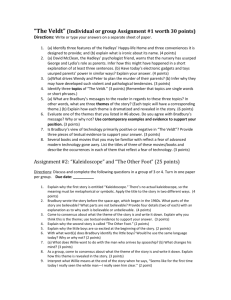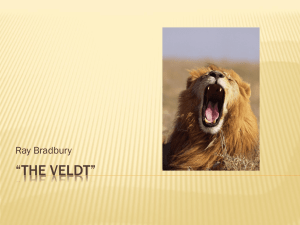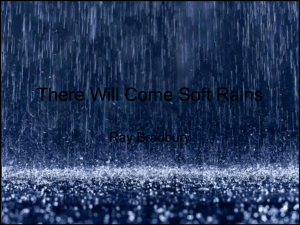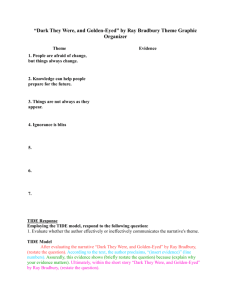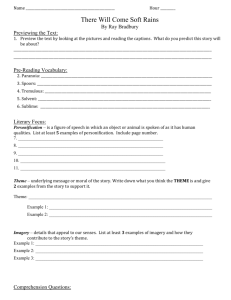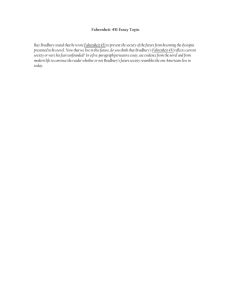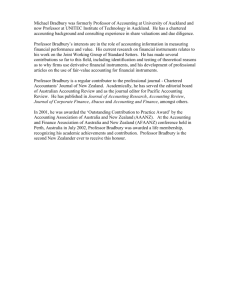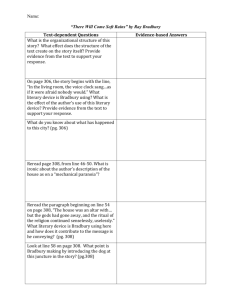“The Veldt” (Individual or group assignment worth 30 points) Group
advertisement
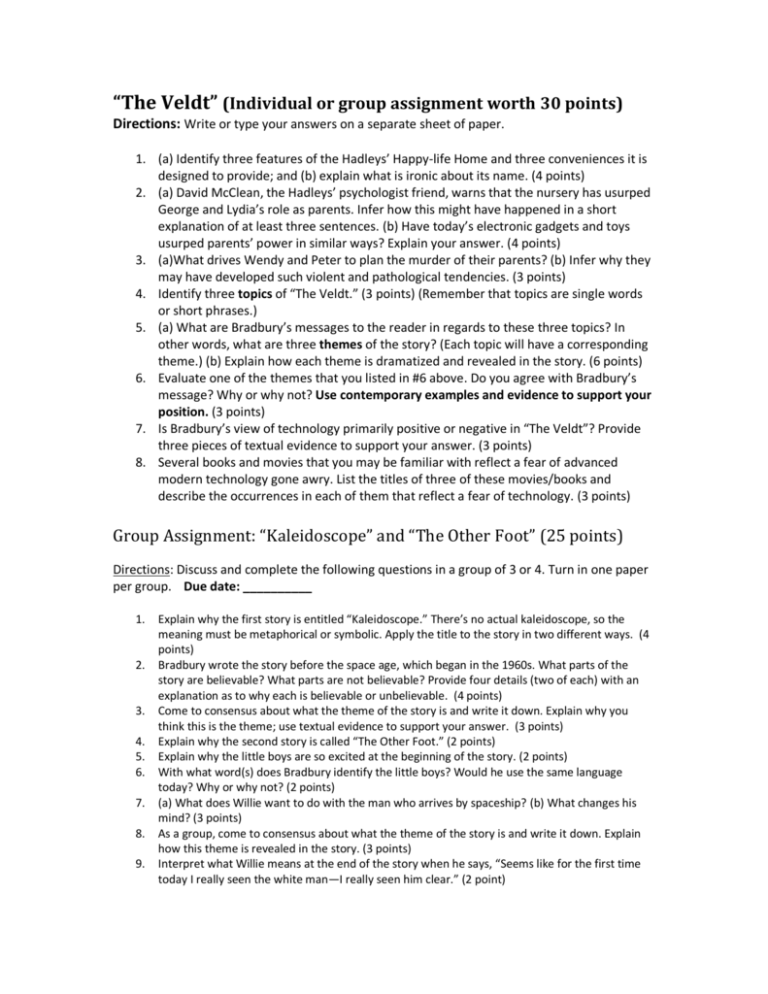
“The Veldt” (Individual or group assignment worth 30 points) Directions: Write or type your answers on a separate sheet of paper. 1. (a) Identify three features of the Hadleys’ Happy-life Home and three conveniences it is designed to provide; and (b) explain what is ironic about its name. (4 points) 2. (a) David McClean, the Hadleys’ psychologist friend, warns that the nursery has usurped George and Lydia’s role as parents. Infer how this might have happened in a short explanation of at least three sentences. (b) Have today’s electronic gadgets and toys usurped parents’ power in similar ways? Explain your answer. (4 points) 3. (a)What drives Wendy and Peter to plan the murder of their parents? (b) Infer why they may have developed such violent and pathological tendencies. (3 points) 4. Identify three topics of “The Veldt.” (3 points) (Remember that topics are single words or short phrases.) 5. (a) What are Bradbury’s messages to the reader in regards to these three topics? In other words, what are three themes of the story? (Each topic will have a corresponding theme.) (b) Explain how each theme is dramatized and revealed in the story. (6 points) 6. Evaluate one of the themes that you listed in #6 above. Do you agree with Bradbury’s message? Why or why not? Use contemporary examples and evidence to support your position. (3 points) 7. Is Bradbury’s view of technology primarily positive or negative in “The Veldt”? Provide three pieces of textual evidence to support your answer. (3 points) 8. Several books and movies that you may be familiar with reflect a fear of advanced modern technology gone awry. List the titles of three of these movies/books and describe the occurrences in each of them that reflect a fear of technology. (3 points) Group Assignment: “Kaleidoscope” and “The Other Foot” (25 points) Directions: Discuss and complete the following questions in a group of 3 or 4. Turn in one paper per group. Due date: __________ 1. 2. 3. 4. 5. 6. 7. 8. 9. Explain why the first story is entitled “Kaleidoscope.” There’s no actual kaleidoscope, so the meaning must be metaphorical or symbolic. Apply the title to the story in two different ways. (4 points) Bradbury wrote the story before the space age, which began in the 1960s. What parts of the story are believable? What parts are not believable? Provide four details (two of each) with an explanation as to why each is believable or unbelievable. (4 points) Come to consensus about what the theme of the story is and write it down. Explain why you think this is the theme; use textual evidence to support your answer. (3 points) Explain why the second story is called “The Other Foot.” (2 points) Explain why the little boys are so excited at the beginning of the story. (2 points) With what word(s) does Bradbury identify the little boys? Would he use the same language today? Why or why not? (2 points) (a) What does Willie want to do with the man who arrives by spaceship? (b) What changes his mind? (3 points) As a group, come to consensus about what the theme of the story is and write it down. Explain how this theme is revealed in the story. (3 points) Interpret what Willie means at the end of the story when he says, “Seems like for the first time today I really seen the white man—I really seen him clear.” (2 point) “The Highway” and “The Man” (Individual assignment worth 20 points) Read the short summaries of the first three stories in The Illustrated Man written below. Notice how each summary, although brief, manages to incorporate each story’s main characters, setting, plot, conflict, and theme. Using these summaries as your models, your job is to write summaries of “The Highway” and “The Man.” Each of your summaries should be of similar length to the ones written below, which range between approximately 125 and 175 words. DO NOT PLAGIARIZE YOUR SUMMARIES FROM AN INTERNET SOURCE! Due date: __________ “The Veldt” — This story examines the downside of advanced technology, particularly when that technology takes on responsibilities abdicated by human beings. In some unknown but seemingly not-too distant future, a family inhabits an automated home that provides them all the comforts and conveniences they need—or so they think. One feature of the home is an artificial nursery that keeps the children happy and frees the parents of any supervisory responsibilities. The children use the high-tech simulation technology of the nursery to create the hostile and predatory environment of an African veldt. When the parents threaten to take the nursery away, the children, obviously more attached to their technological addictions than their own parents, lock their parents inside the veldt, where they are mauled and killed by the "harmless" machinegenerated lions of the nursery. "Kaleidoscope" — How will you feel about the way you lived your life just before the moment of your death? This amazing story examines that provocative question. After the rocket he inhabits explodes, a bitter astronaut feels he has accomplished nothing worthwhile in his life as he and the rest of his crew fall irrevocably to their demise. The story illustrates the collapse of the sanity and logic of the crew members as they encounter imminent death and are forced to face the value of their lives. Ultimately, the lamenting narrator, who wishes that his unfulfilling existence would at least be worth something for someone, is incinerated in the atmosphere of the Earth. His burning form appears as a shooting star to a child, who makes a wish, offering a kind of personal redemption for the protagonist. His demise offers hope to another—even though he didn’t live the life he wanted for himself. "The Other Foot" — Will humans advanced enough to inhabit other planets be able to overcome the prejudices of the past? Bradbury explores that question in this narrative. When the story opens, Mars has been colonized solely by black people in a setting that was about 35 years into the future when Bradbury wrote the story in the late 1940s. When the colonists learn that a rocket is coming from Earth with white travelers, they institute a Jim Crow system of racial segregation in which white people are to be considered second-class citizens, in retaliation for the history of wrongs perpetrated on their race by whites. When the rocket lands, the traveler tells them that most of the Earth has been destroyed in a war and asks for their help. The people, led by the protagonist, Willie, realize that discrimination is harmful in all its forms, and reverse their planned segregation. Encouraging tolerance and acceptance of others, Bradbury presents a hopeful vision of human interaction stripped of prejudice and hatred. NOTE: CHOOSE ONE OF THE FOLLOWING TWO ASSIGNMENTS “The Long Rain” (Group assignment worth 25 points) 1. Write a song, rap, or poem about the story and present it to the class. (Minimum: 20 lines) 2. Summarize the story in a comic strip or story board. You should include at least six pictures, and each picture should have a caption that describes the action or includes dialogue. Make sure to include the key events. 3. Conduct an interview with the lieutenant after the events of the story take place. Your interview should include at least ten questions and answers and should reflect on some of the action that occurs in the story. “The Rocket Man” (Individual writing assignment worth 25 points) 1. Write a eulogy (tribute) for the rocket man that his son or his wife (or both) reads (read) at his funeral. (Minimum length: One page typed. Maximum length: Two pages typed.) 2. Flash forward twenty years and write a story or a journal entry from the son’s point of view. What is he doing now? Is his mother still alive? If not, what happened to her? If she is alive, what kind of relationship does the son have with her? How has the world changed since his father died? (Minimum length: One page typed. Maximum length: Two pages typed) “The Fire Balloons” and “The Last Night of the World” (Group Assignment worth 25 points) Directions: Answer the following questions over “The Fire Balloons” (questions 1-5) and “The Last Night of the World” (questions 6-10) with a small group on a separate sheet of paper. You may turn in one paper per group. Due date: _______ 1. What three questions in succession that highlight an important theological dilemma in the story does Father Peregrine ask himself on the first page of the story? (1 point) 2. (a) Why is Father Peregrine traveling to Mars? (b) Why did the Bishops think he was the right man for the job? Support both of your answers with textual evidence. (3 points) 3. (a) How are the personalities of Father Stone and Father Peregrine different? List two differences and provide specific textual evidence from the story to support your answer. (Hint: Look up the word “skeptic” in the dictionary and apply the definition to one of the two characters.) (b) With which of the two characters do you think Bradbury sympathizes more? Explain your answer. (5 points) 4. (a) How many times do the blue orbs of light prevent Father Peregrine’s death? Explain what happens each time. (3 points) 5. How does Father Peregrine intend to introduce Christ to the Martians? (b) Why does he receive resistance from the other priests? (2 points) 6. Summarize the story that the blue orbs of light tell the priests on pp. 88 - 89. (2 points) 7. What is the theme of “The Fire Balloons”? Support your answer with textual evidence. (3 points) 8. What type(s) of irony (verbal, situational, and/or dramatic) applies (apply) to “The Last Night of the World”? Support your answer with textual evidence. (2 points) 9. Do you think the characters in “Last Night” act realistically? Why or why not? (2 points) 10. In the conversation between the husband and his wife, an implied reason for the end of the world is suggested. What is that reason? Provide textual evidence in support of your answer. ( 2 points) “The Exiles” and “No Particular Night or Morning” (Group or individual assignment worth 25 points) Option One Directions: Answer the following questions over “The Exiles” (questions 1 – 5) and “No Particular Night or Morning” (questions 6 – 10) with a small group on a separate sheet of paper. You may turn in one paper per group. Due date: ___________ 1. (a) What is an exile? Provide a definition of both the noun and verb form of the word. (b) Who are the exiles in this story? (c) From where to where have they been exiled? (d) Why have they been exiled? (3 points) 2. (a) Define the verb allude and the noun allusion. (b) Identify at least two literary allusions made by Bradbury in this story. (3 points) 3. Why are the crew members of the rocket ship having nightmares? Provide evidence from the story to support your answer. (2 points) 4. What happens to the exiles at the end of the story? Explain how and why. (2 points) 5. (a) When he published this story in 1950, what was Bradbury suggesting about the future of classic literature? (b) Was Bradbury’s vision prophetic or accurate—in other words, has anything he envisioned come true? Explain your answer. (3 points) 6. In order for something to be real for Hitchcock, what conditions must be met? Include evidence from the story to support your answer. (2 points) 7. Research the terms rationalist and empiricist. Is Hitchcock a rationalist or an empiricist? Explain your answer. (3 points) 8. What factors in Hitchcock’s past may have contributed to his mental state? Provide three relevant facts from his past life, and be specific and detailed. (3 points) 9. Why do you think Hitchcock “walked out into space—alone”? Explain your answer. (2 points) 10. In your opinion, is Hitchcock insane? Explain your answer. (2 points) Option Two directions: Write summaries of both stories. Use the same guidelines as the summaries you wrote for “The Highway” and “The Man.” This is an individual assignment; do not turn in summaries with more than one student’s name on the paper. Option Three directions: (Choose One) 1. Write a song, rap, or poem about one of the stories and present it to the class. (Minimum: 20 lines. Must be presented to the class.) 2. Summarize one of the stories in a comic strip or story board. You should include at least six pictures, and each picture should have a caption that describes the action or includes dialogue. Choose the most important events! 3. Draw portraits of a main character from each story. Envision what the characters would be wearing and what they would look like, and try to capture the character’s personality in your drawings. Include a descriptive paragraph of each character with your drawings. Also, this is an individual assignment, so do not turn in portraits/descriptions with more than one student’s name on the paper. Assignment for pages 114 – 186 of The Illustrated Man Directions: Please read the final seven stories and the epilogue of the novel by the following due date: ______________. Choose three of the seven stories to analyze, using the format below. (Each analysis is worth 25 points). 1. Identify the title of the short story and explain why it’s an appropriate title for the story. (1 point) 2. List and describe the important characters (including the protagonists and antagonists). Include physical (if known) and personality characteristics and explain the characters’ roles in the story. (6 points) 3. Describe the setting (where and when). Provide a generalized backdrop as well as specific descriptive details. (4 points) 4. Describe the story’s central conflict [list both forces that are opposing each other: write your conflict as person(s) vs. _________ and fill in the blank]. (2 points) 5. Write a plot summary of seven to ten sentences. Include the essential events. (6 points) 6. Identify three main topics of the story. (Remember: topics should be written as single words or short phrases.) (3 points) 7. Identify the most important theme of the story. (Remember: a theme is a generalized truth that applies to all humanity, not to just a particular story or particular characters.) Explain how this theme is dramatized and revealed in the events and details of the story. (3 points) Due date of 1st analysis (choose either “The Fox and the Forest” or “The Visitor”): _______________ Due date of 2nd analysis (choose either “The Concrete Mixer,” “Marionettes, Inc.,” or “The City”): ___ Due date of 3rd analysis (choose either “Zero Hour” or “The Rocket”): ________________________ The Illustrated Man: Final Essay (Individual assignment: 40 points) Directions: Write an essay on one of the following questions. Give your essay an appropriate structure and be sure to include a thesis statement. Minimum length: 3/4 page typed (double-spaced, 12-point font, 1” margins). Maximum length: 1 ½ pages typed (double-spaced, 12-point font, 1” margins). Due Date: __________ 1. Topic: Futuristic Technology Thesis: Although futuristic technology will provide humankind many conveniences and much freedom, Ray Bradbury foresees several negative consequences of advanced technology. (You’re welcome to put this thesis into your own words.) Supporting Details: Include supporting details from at least three stories. 2. Topic: Family (Parent/child and spousal) relationships Thesis: Write your own thesis regarding the following issues: How will family relationships, personal freedom, family structures and human interactions be affected by technology or other factors in the future? Supporting Details: Include supporting details from at least three stories. 3. Topic: Your choice Thesis: Your choice Supporting Details: Include supporting details from at least three stories.
